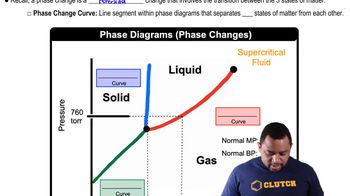Here are the essential concepts you must grasp in order to answer the question correctly.
Vapor Pressure
Vapor pressure is the pressure exerted by a vapor in equilibrium with its liquid or solid phase at a given temperature. For water at 25 °C, the vapor pressure of 0.0313 atm indicates the tendency of water molecules to escape from the liquid phase into the gas phase. This concept is crucial for understanding the behavior of substances in equilibrium and is foundational for calculating equilibrium constants.
Recommended video:
Raoult's Law and Vapor Pressure
Equilibrium Constant (Kp and Kc)
The equilibrium constant (K) quantifies the ratio of the concentrations of products to reactants at equilibrium. Kp is used for gas-phase reactions and is expressed in terms of partial pressures, while Kc is used for reactions in solution and is expressed in terms of molar concentrations. The relationship between Kp and Kc is given by the equation Kp = Kc(RT)^(Δn), where Δn is the change in moles of gas, R is the ideal gas constant, and T is the temperature in Kelvin.
Recommended video:
Phase Equilibrium
Phase equilibrium occurs when the rates of the forward and reverse processes of a phase change are equal, resulting in no net change in the amounts of each phase. In the context of the reaction H2O(l) ⇌ H2O(g), this equilibrium is influenced by temperature and pressure. Understanding phase equilibrium is essential for calculating Kp and Kc, as it helps to determine the concentrations or pressures of the reactants and products at equilibrium.
Recommended video:
Phase Changes in Diagrams




